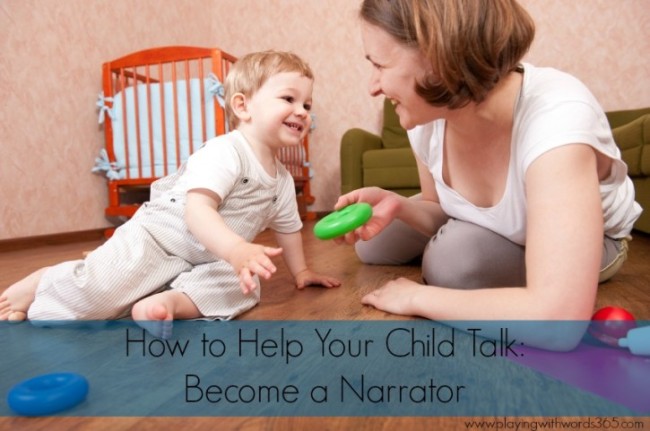Welcome to my How to Help Your Child Talk series. These posts are intended to give you simple tips to help you work with your child so YOU can be your child’s best “speech therapist.†You may want to try out a new tip/strategy for a week or so and then when you feel like you’ve “got it† and it comes more naturally, move on to a new tip and incorporate that into your day for another week or two. For a list of  all my tips, go HERE. This post contains affiliate links to Amazon for your convenience.Â

I recently posted about the research regarding the importance of quantity and quality of the words we speak to our children in the first few years of life. We know that just the mere quantity of words spoken alone has a huge impact on our child’s speech and language skills. One way to get talking to help expose your child to lots of language, especially to children with limited communication skills (infants, toddlers and older children with delays) is to become a narrator during your daily activities and routines as well as during your child’s play Narrating allows your child to hear lots of language in a meaningful way. There are two main types of narrations: self talk and parallel talk.
Narrate Your Actions: Self Talk
The first type of narrating is called self-talk. This is when you are using short sentences to talk about or describe what you are seeing, hearing or doing when you are with your child. For example, when you are making cookies you may say “Mommy is making cookies! I am putting the chocolate chips in the batter! I am stirring. I am putting them in the oven†and so on. Have you ever been in the store and heard a person talking and talking to themselves until you realize that they have a baby strapped to their chest? (Or maybe you have been the one blabbering on to your infant in Target and gotten ‘the looks†from people thinking you are crazy? 😉 ) That’s self talk! Now, this self talk for some people comes naturally and for others, they need to make an effort to do it. Those of us who are generally more quiet natured may have a harder time with this skill, and that is ok! As I explain in a bit, you don’t have to do this all day long so you can ease into this strategy slowly if you find yourself uncomfortable talking about yourself all the time!
Narrate your Child’s Actions: Parallel Talk
The other type of narration is called parallel talk. Parallel talk is similar to self talk, except rather than talking about or describing what you are seeing, hearing or doing you are talking about or describing what your child is seeing, hearing or doing. This requires those listening with our eyes skills we learned a few weeks ago. So when your child is playing with blocks you might say “Wow! You you are building a tower! Oh you have the blue block. You threw the red block!†This is much like sportscasting: You are watching the action and describing that action to your child. For an infant, this might sound like this: “You are holding a rattle! Shake shake! You are shaking the rattle!” or “You are crawling toward the basket! You are pulling the basket over!” and so on.
No Questions, No Expectations
Notice in self talk and parallel talk, you are not asking questions of the child nor are you expecting the child to imitate you. These strategies are intended to expose your child to meaningful language, not to generate a response from him. If he DOES imitate you or respond, that is awesome! But, it is not the intent of the strategy.
When Should I Use These Strategies?
The best times to use these strategies are during regular routines and within your child’s play. Some examples include:
- Diaper changes
- Getting dressed
- Preparing meals
- Meal time
- Bath time
- Outdoor play (including the park)
- Outings like at the zoo or a museum
- PLAY TIME!
How Often Do I Do This?
You don’t want to do this constantly. It is very common for people to over do these strategies in the beginning. Think of self talk and parallel talk like a conversation: There needs to be pauses and chances for turn taking. Even though your child may not be taking a turn talking he does need the chance to take a turn to listen and process what he is hearing. Narrate one or three actions, and then stop, wait and watch.
Have you used self talk or parallel talk yet with your child? Do you find it comes naturally, or do you find you struggle with these skills?
Next up, we are going to talk about expanding your child’s words, so check in soon. For a list of  all my other tips, go HERE.
Looking for more ways to help with your child’s speech and language development? ? I highly recommend these two books: My Toddler Talks: Strategies and Activities to Promote Your Child’s Language Development by fellow SLP and friend Kim Scanlon and It Takes Two To Talk: A Practical Guide For Parents of Children With Language Delays
 from The Hanen Centre.
DISCLAIMER: My tips are for informational purposes only and do NOT replace the interventions of a licensed and certified speech-language pathologist. Please read my full disclaimer and terms of use page for more information.Â
[…] talk about what you’re doing. Be like a sports caster who’s giving a play-by-play. Narrate your […]